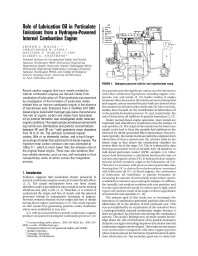Mining Publication: Role of Lubrication Oil in Particulate Emissions from a Hydrogen-Powered Internal Combustion Engine
Original creation date: October 2007
Authors: AL Miller, CB Stipe, MC Habjan, GG Ahlstrand
NIOSHTIC2 Number: 20032816
Environ Sci Technol 2007 Oct; 41(19):6828-6835
Recent studies suggest that trace metals emitted by internal combustion engines are derived mainly from combustion of lubrication oil. This hypothesis was examined by investigation of the formation of particulate matter emitted from an internal combustion engine in the absence of fuel-derived soot. Emissions from a modified CAT 3304 diesel engine fueled with hydrogen gas were characterized. The role of organic carbon and metals from lubrication oil on particle formation was investigated under selected engine conditions. The engine produced exhaust aerosol with log normal-size distributions and particle concentrations between 105 and 107 cm-3 with geometric mean diameters from 18 to 31 nm. The particles contained organic carbon, little or no elemental carbon, and a much larger percentage of metals than particles from diesel engines. The maximum total carbon emission rate was estimated at 1.08 g h-1, which is much lower than the emission rate of the original diesel engine. There was also evidence that less volatile elements, such as iron, self-nucleated to form nanoparticles, some of which survive the coagulation process.

NIOSHTIC2 Number: 20032816
Environ Sci Technol 2007 Oct; 41(19):6828-6835
- Aerosols Emitted in Underground Mine Air by Diesel Engine Fueled with Biodiesel
- Control Technologies and Strategies for Reducing Exposure of Underground Miners to Diesel Emissions
- Diesel Exhaust Aerosol, Review of Measurement Technology
- The Effects of Water Emulsified Fuel on Diesel Particulate Matter Concentrations in Underground Mines
- Instrumentation for Diesel Particulate Matter Emissions Research
- Mutagenicity of Diesel Exhaust Particles from an Engine with Differing Exhaust After Treatments
- Real-Time DPM Ambient Monitoring in Underground Mines
- Sampling Results of the Improved SKC� Diesel Particulate Matter Cassette
- Size Distribution and Deposition in Human Respiratory Tract: Particle Mass and Number
- Technology News 514 - The Air Quantity Estimator (AQE): A New Computer Software Tool for Large-opening Mine Ventilation Planning